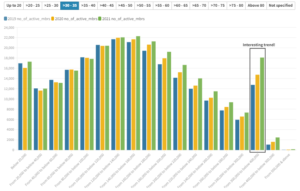Like any investment strategy, there will always be risks and it is important to understand these risks before executing the strategies. On the other hand, we can’t decide on whether an investment is worthwhile by solely looking at the risks involved, we need to assess the risks relative to the potential reward. In short, we should avoid investments with unfavourable risk-reward ratio and be prepared to take reasonable risks when the risk-reward ratio is assessed to be favourable. This is the approach I took when deciding to embark on 1M65 strategies.
Like many, one of my major concerns when I was considering to go all out on achieving FRS in SA asap was the uncertainty of future CPF policies. Policy risk is a legitimate concern which should not be ignored. However, we should also not let the fear of unknown overwhelm us.
While I have covered extensively on the benefits of achieving FRS asap in previous articles, I would like to share my thought process below on potential policy risks. This is purely my personal views, based on my own risk appetite, inclinations and circumstances and yours will definitely be different.
“What if CPF/Government ….”
- Extends CPF withdrawal age beyond 55 yo
- Lowers CPF interest rates
- Increases FRS escalation rate
- Revamps CPF System
As my CPF projections are based on some general assumptions, any of the above policy changes will impact my projections. To assess the risk of each scenario, I take into consideration its potential impact, probability of occurrence and any mitigating factors that could minimize their impact.
1) Extending CPF withdrawal age to beyond 55 yo
Impact:
A postponement in CPF withdrawal age from 55 yo would delay my semi-retirement plan as the excess of retirement sum (BRS, FRS or ERS) will not be available for draw-downs at 55.
Probability:
As retirement age has been increasing, it is possible that withdrawal age may be shifted as CPF members may not require the funds yet since most may still be employed. However, ‘shifting this goalpost’ could be a sensitive issue.
I personally believe that it is in the interest of our government to help more citizens to secure reasonable retirement savings, and a possible avenue to do so could be postponement of CPF withdrawal age to allow for accumulation of more funds in CPF. However, government should then implement a targeted approach to support those who fall short of minimum retirement sum. Withdrawal of excess CPF amount at 55 should still be allowed for those who are able to meet minimum retirement sum by 55.
While I do recognise the potential risk, I believe the possibility of extension of retirement age across the board remains slim for now.
Mitigation:
I do not plan for CPF to be my main source of income when I retire. A postponement in withdrawal age also suggests that my money would compound for a few more years in SA. One of the reasons for topping up my SA to FRS early, is to maximize the compounding period before funds (from SA and/or OA) are transferred to RA at 55. Postponing the withdrawal age will increase the compounding period, which may not necessarily be a bad thing.
Assessed Risk: Low
2) Lowering of CPF interest rates
Impact:
My CPF projections will be much lower should the interest rates drop. The worst-case scenario would be the impact on my plans to semi-retire at 55 and fully retire at 65.
Probability:
In the worst-case scenario of a worsening economy, there is possibility that CPF rates may decrease. The government’s response in a bad economy, like the current economic climate which is severely impacted by an unprecedented event like COVID-19, could be a good gauge of what our government will do during such times. At least till now, even having drawn on $52 billion of reserves, cutting CPF rates has not been surfaced as a potential measure.
I strongly believe that any decision to lower CPF interest rates will not be an easy one as this would have negative impact on citizens’ retirement plans – possible repercussions of citizens not meeting their retirements needs. In a recent report, CPF Board expects 7 in 10 active CPF members from 2021 and 2022 cohorts to meet BRS. A population that has a huge proportion of elderly not having enough at retirement would potentially cause a strain on the government.
Since OA’s minimum interest rate of 2.5% is mandated by law , it is unlikely to be lowered. However, this may not be the case for the current floor rate of 4% for both SA and MA which are reviewed quarterly. Nonetheless, I feel that there should be a reasonable difference in rates between OA and SA/MA as the usage of SA/MA funds is more limited. Should SA/MA interest fall to 3% or lower, I believe it would definitely be challenging to incentivize citizens to ‘lock’ their monies in SA/MA.
Mitigation:
There is nothing much to be done. If it happens, I just have to make do with lower balances. At least, my funds are still secured. In the meantime, I would enjoy the 4% rates while it last.
Assessed Risk: Medium
3) Increasing FRS escalation rate
Impact:
CPF FRS amount currently increases at about 3% each year. If this rate increases further, more monies will need to be set aside in RA at 55, reducing my potential draw-down at 55.
Probability:
I believe the current escalation rate at 3% is already steep. Increasing it further will impact more citizens, especially the younger generations, as it makes it more challenging for them to achieve FRS. For example, if escalation rate increases to 4%, for someone who is currently 25 yo, FRS will be $576K when he turns 55!
Mitigation:
The best way to mitigate this risk is to meet FRS earlier. If there is subsequent continuous CPF contribution towards SA, the eventual SA amount would exceed the prevailing FRS, and the annual interest should be sufficient to offset potential FRS increase. However, the amount available for draw-downs at 55 would be lower as more funds would be ‘trapped’ in RA.
Assessed Risk: Low
4) Revamping of CPF System
This would be a black swan event should it happen. The major review that revised the Minimum Sum Scheme to the current 3-tier retirement sum model (BRS/FRS/EHS) was in 2015, which was just a few years ago. I do not anticipate a need to revamp the system in the near future at least. Even if it does, I believe CPF/Government’s policies are designed to help more citizens secure their retirement. Hence, any policy changes will most likely be made with similar considerations.
Assessed Risk: Low
Verdict
Overall, I feel that the risk concerning policy changes is low relative to the potential reward. However, all risk assessment can be very subjective, depending on one’s risk profile. There is no right or wrong. I may still be wrong because there is still some risks but I’m willing to accept the risks as I assessed that the potential rewards of being right in my assessment far outweighs the risk. In the ultimate worst-case scenario, my monies will still be secured in CPF and it will still be mine and at least it would not disappear into thin air like how some other riskier investments could.
As Warren Buffet said, ‘Risk comes from not knowing what you are doing’. As long as you have done your due diligence and developed the necessary conviction, you would be comfortable in taking action and executing your plan.
May the force be with you!



